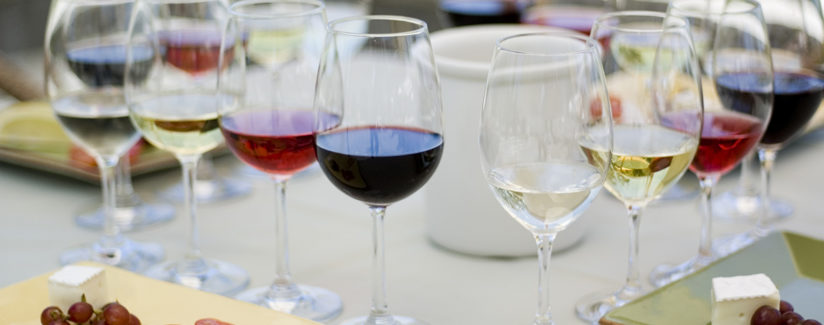
A Glass of Merlot? Wine Not?
07/29/2016
Now that we know what makes wine taste good (a lot of science!), let’s get to the important stuff – is wine healthy? And is red wine exercise in a glass? Is red wine healthier than white wine? For more information, we asked Best Food Facts registered dietitian Sarah Downs and Dean Volenberg, PhD, Director, Grape and Wine Institute and Assistant Extension Professor, Viticulture and Winery Operations, from the University of Missouri’s College of Agriculture.
According to Dr. Volenberg, phytonutrients, such as tannins, and anthocyanins are extracted from grape skins during the winemaking process. Since red wines are made from grapes fermented with skins and seeds, red wines will have more phytonutrients than white wines, which are made from grapes fermented without the skins and seeds.
But what are phytonutrients and anthocyanins and why do we need them? Best Food Facts registered dietitian, Sarah Downs, tells us phytonutrients or phytochemicals are found in plant foods. Phytonutrients literally means “plant nutrients.” Phytonutrients are found in many plant-based foods like fruits, vegetables, whole grains, nuts, beans, tea and wine! Like vitamins, phytonutrients can be beneficial to human health and helpful in preventing various diseases. They can also help protect the plants that contain them from germs, fungi, bugs and other threats. There are over 25,000 phytonutrients found in plant foods, the six most common being carotenoids, ellagic acids, flavonoids, resveratrol, glucosinolate and phytoestrogens. In addition to the health benefits, phytonutrients are often responsible for the vibrant colors found in fruits and vegetables. For example, tomatoes and watermelon get their pretty red color from the phytonutrient lycopene. That being said, the best way to ensure you are making the most of the different phytonutrients found in these foods is to eat a “rainbow” of fruits and veggies.
Okay, so what are anthocyanins?
Within 6,000+ members of the flavonoid family of polyphenol phytochemicals or phytonutrients, there is a particular group of compounds known as anthocyanins. Anthocyanins provide the bright red-orange to blue-violet colors of many fruits and vegetables, the amount of which can vary greatly depending on the food. Anthocyanins act as a protective mechanism for plants against environmental stressors like ultraviolet light, cold temperatures and drought. Though there’s still a lot to learn about this type of flavonoid, there has been extensive research linking its role in helping reduce the risk of cardiovascular disease, cognitive decline and cancer.
If wine contains phytonutrients and anthocyanins, does that make it healthy?
Sarah Downs, RD: “Originally, red wine specifically was thought to be healthy due to the “French Paradox.” In some parts of France where they eat foods high in saturated fats and have high rates of smoking, the rates of heart disease are low. These people also drink lots of red wine, so researchers began to study whether there were compounds in red wine that protected against heart disease. The grape skin and seeds in wine (especially red) are rich in the antioxidant resveratrol, which may help prevent chronic disease. Red wine has more resveratrol than white because it is fermented with the skins on and white is not. To date, there isn’t enough good quality research to say whether red wine has a protective effect on health. Some studies have been done on the effect of the antioxidant resveratrol on protection against cancer and in some animal studies it has been shown to slow down the growth of cancer cells, but there is no proof this would be the same way for humans. Fortunately, you don’t need to be a wine drinker to get some resveratrol in your diet — grapes, blueberries, raspberries, grape juice and cranberry juice also contain the antioxidant.
“As with all foods, wine should be consumed in moderation because drinking too much of any alcohol increases the risk of high blood pressure, high triglycerides, liver damage, obesity, mental illness, some cancers and other health conditions, not to mention it has a significant amount of calories. According to the Dietary Guidelines for Americans, drinking moderately means up to one drink per day for women and two drinks per day for men. One drink is 12 ounces of beer (if 5% alcohol), 5 ounces of wine or 1.5 ounces of 80-proof spirits. And if you don’t already drink red wine, don’t start drinking for the few health benefits it may provide.
“Bottom line — there is not one single health benefit you can get from wine that you can’t get from eating a balanced diet that includes lots of fruits, veggies, whole grains, legumes, dairy and lean protein. Rest easy knowing that you can enjoy that glass of wine. Just do so in moderation.”


























